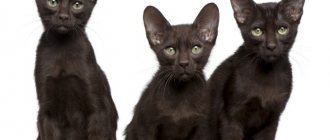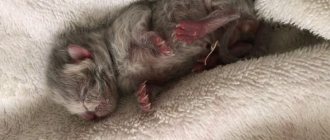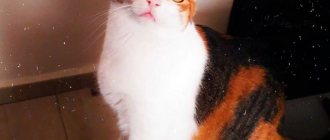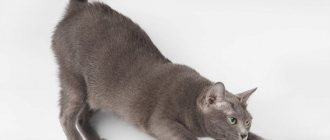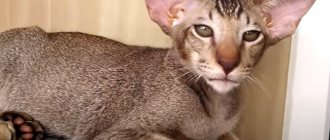What does color depend on?
Like any other animal, the color of a cat's eyes is determined by genetics. In domestic specimens, the hue usually ranges from blue and green to yellow, orange and copper tones, which are often mistaken for brown. But wild cats, such as the lynx, have really brown eyes.
The shade of a cat's eyes depends on the amount of melanin, the level of which in the animal's body also affects the color of the skin, mucous membranes and fur. The more melanin, the darker the coat and eyes. But there are exceptions - light-eyed pets with dark fur and vice versa.
When does a kitten change eye color?
Due to the fact that the coloring pigment accumulates gradually, the animal receives its “native” eyes, created by nature, by the age of one and a half years.
It all depends on the individual animal, but generally the most striking changes occur between the ages of four weeks and one year. When a kitten begins to see, its eyes appear vaguely cloudy. If the owner wants a pet with a specific eye color, it is better to make the choice at three months of age - then the constant color shade will be clearly visible.
Green-eyed breeds
Long-haired and short-haired Persians with a chinchilla-colored coat are known for their green eyes with a black “rim.” The Tonkinese breed has striking sea green eyes.
Russian Blue cats have emerald green eyes that contrast beautifully with their gray-blue coat. And the Egyptian Mau's irises resemble juicy gooseberries.
Breeds of blue-eyed cats with white fur
Not every cat breed can boast representatives who simultaneously have white fur and blue eyes. However, they still exist. The category of smooth-haired, fluffy and bald snow-white blue-eyed tailed beauties includes: Russian White, Oriental, British, Scottish Fold, Persian, Foreign White, Kao Mani, Maine Coon, Turkish Angora, Javanese, Sphynx, Cornish Rex. Information about the listed animals is presented in the table:
Oriental
Name of the breed, representatives of which may have white fur and blue eyes Interesting facts Character features Oriental exotic appearance; talkativeness; the habits of white cats of this breed resemble those of a dog; these pets love to climb onto high objects, so damage to property in the house where the Oriental lives is inevitable; At birth, kittens often have dark spots in the ears and arrows near the eyes, which disappear as they grow older.
friendliness; attachment to the owner; activity; intelligence; need for constant attention; loyal attitude towards other animals, including dogs; playfulness; craving for petty mischief.
The British cat has thick, pleasant to the touch fur, reminiscent of plush; white cats of this breed do not like to sit on laps; tendency to obesity; good health.
livability; phlegm; good nature; unpretentiousness; unobtrusiveness; the ability to occupy oneself in the absence of household members; a loyal attitude towards other four-legged inhabitants of the house and children, provided that the latter do not persistently show tender feelings or neglect.
Scottish cat Scottish fold cats are afraid of heights; These white cats do not like to sit on your lap; are not inclined to attract attention to themselves with their voice.
delicacy; patience; intelligence; devotion; equilibrium; vulnerability and sensitivity; the need for constant communication with the owner; non-conflict; loyal attitude towards children.
Persian cat Persian cats are suitable exclusively for indoor keeping; most of the time they doze, sleep or just lie down; rarely “talk”; remember grievances for a long time; Persian cats have a tendency to overeat.
friendliness; equilibrium; intelligence; attachment to the owner; need for constant attention; loyal attitude towards other animals and children.
Foreign whites are sensitive to ultraviolet light; Their habits resemble those of dogs.
sharp mind and observation; sociability; playfulness; devotion; curiosity; the need for constant communication with the owner; increased talkativeness; loyal attitude towards children and other pets.
Kao-mani, no matter what insult was inflicted on these cats, they are able to remember it for the rest of their lives; high price; talkativeness
curiosity; mobility; playfulness; intelligence; need for a companion animal; obsession; gullibility; friendliness.
Maine Coon is large in size; have habits similar to those of dogs; have a thin voice; love of water procedures.
equilibrium; unobtrusiveness; able to adapt to the owner’s habits; do not like increased displays of tenderness; livability.
Turkish Angoras do not try to attract attention to themselves using their voice; swim well if they are accustomed to swimming from childhood; pronounced hunting instinct.
tendency to chase small animals; devotion to one master; independence; waywardness; tendency to damage property; persistence; livability; developed intelligence.
The Javanese cat is in fairly poor health; They love to purr, but they do it quietly.
devotion to one master; stubbornness; need for increased attention; tendency to damage interior items; playfulness; love for children; loyal attitude towards other animals; aggression may occur.
Sphinx exotic appearance; lack of hair; need for special care.
sociability; increased attachment to the owner; playfulness; need for constant communication; lack of aggression; loyal attitude towards children and other animals.
Cornish Rex is almost completely free of genetic diseases; love of heights; original appearance.
increased activity; obsession; tendency to jealousy; need for increased attention; easy learning; unpretentiousness; calm, sometimes indifferent attitude towards children.
Russian White These animals are descendants of the Russian Blue cat; high price.
non-conflict; equilibrium; resistance to stress; lack of need for constant communication.
Sphinx
Cats with different eyes
Heterochromia (eyes of different colors) is a gene mutation. In this case, the white color gene blocks the distribution and concentration of another pigment in the iris during the cat's development. The mutation can be hereditary or acquired as a result of a developmental defect, disease, or injury.
Heterochromia is most common in white cats - they usually have one eye that is blue and the other eye that is green, hazel, copper, yellow or orange. The most famous breeds with this mutation are Turkish Angoras, Japanese Bobtails, Persians, Sphynxes and Oriental Shorthairs.
When to expect changes
The process occurs differently in different breeds, with time frames ranging from 1-12 months. In outbred animals it often begins at the age of 1-1.5 months. In Scottish and other purebred kittens, eye color usually changes between 4 and 12 months. The so-called “true cat color” of the iris is finally formed towards the end of the second year of life. On days 10-14, when a newborn kitten opens its eyes, they are usually covered with a cloudy film, which is why they appear cloudy. Approximately by a month, the film disappears, so the iris appears brighter. Then, as the pigment grows and accumulates, its color changes and the shade becomes more pronounced. It is quite difficult to determine exactly what it will be like in the end, since the color palette is very diverse: from gray to red (for albinos).
The main colors of cat eyes are:
- green;
- yellow;
- copper;
- blue.
Although blue eyes in an adult animal are, in fact, a sign of insufficient production of melanin by the body. In its absence, short waves of visible light (which the human eye perceives as blue) are scattered in the iris, as happens in the atmosphere, which is why the eyes appear blue, like the sky.
According to the observations of felinologists, if a kitten is born with yellow eyes, over time they become brighter (even copper, amber), but never acquire a blue tint. Although a change from blue to yellow and even brown is quite possible.
If you want to become the owner of a kitten with a certain eye color, it is better to take your pet home after 4 months. By this time, the main shade is usually formed, which over time can only become more saturated and deeper.
Dichromatic eyes
In this case, the pet has two shades of the iris on one eye. Sometimes it looks like a colored ring around the pupil of a different shade, or the eye is divided into two different colored fragments.
Important! Judges at professional cat shows consider this a disadvantage, but amateurs consider it a cute and attractive feature. Sometimes mirror dichromacy occurs in both eyes at once.
Tips on how to distinguish a cat from a cat
Primary signs of sex in cats can be distinguished from birth. You can examine the kitten yourself, tactilely or visually. In the first case, you need to wash your hands thoroughly, make sure they are not cold, and place the kitten in your palm. If the baby is wary or worried about something, it is better to leave the check. The second way is to simply look at the genitals and anus. In a male they closely resemble a colon, while in a female they resemble an exclamation point. In addition, cats can boast of quite thick hair between these “points”, unlike female cats. Experienced cat lovers can determine gender by the shape of the face and body:
- the cat has a wider muzzle and nose;
- his physique is more massive, his paws are thicker;
- the cat is more graceful;
- Cats have an elongated muzzle.
Boy and girl
Calico cats are almost always (with very rare exceptions in the form of a genetic disease) cats, since the calico gene is associated with the X chromosome, which only girls have. When kittens are four to five months old, they begin puberty and their hormonal levels change dramatically. They may ask to go outside and meow loudly. Males tend to mark territory and may try to mate with females. Females can experience all the delights of the first heat, during which, under the influence of awakened hormones, they begin to scream loudly, rub their muzzle against the owner’s legs, and squirm. However, it should be remembered that early pregnancy is undesirable for a cat.
Albinos
Many people mistakenly believe that albinos are individuals with white fur. In fact, albino cats have no melanin at all, meaning they are actually colorless rather than white.
Therefore, the eyes of such individuals will be pale blue or lavender. And technically it's not the hue of the iris, but a reflection of blood flow in the back of the retina.
Important! White cats with sapphire or cornflower blue eyes are definitely not albinos.
Reasons for color change
Most kittens are born blue-eyed, but this does not mean that they will remain blue-eyed throughout their lives. The blue tint visible to the human eye is not the real color of the iris, but an indicator of a low level of the coloring pigment - melanin. The less it is, the colder the shade will be.
It is at birth that the level of pigments in the body is minimal. They continue to accumulate during the first months of life as the visual organs develop, which contributes to color changes. This process is called reblooming. Multi-colored inclusions appear on the already familiar blue iris. Their size gradually increases until the eyes acquire a constant color.
Eye color and pet health
White cats with blue eyes are often deaf. Albinos are sensitive to bright light. But if an adult has changed the color, brightness or depth of the eye shade, then it should definitely be shown to a veterinarian. Since this can be a symptom of several ailments at once.
The appearance of orange eyes may be a sign of uveitis, an inflammatory process. The cause may be diabetes, injury, fungal or bacterial infections, herpes or cancer.
Darkening of the irises may indicate an increase in red blood cells in the blood. The appearance of a “foggy” look indicates cataracts or glaucoma. Eye coloration in a brownish-copper shade indicates liver shunts.
Uveitis in cats.
During the first three months of life, cat eye color develops and acquires its final shade. Some cats may have different colored eyes, while others may have one eye with two distinct colors.
A change in eye color in an adult cat is an alarming sign as it may be a signal that the cat has serious health problems. Uveitis, or inflammation of the choroid of the eyeball, can cause a significant and sudden change in eye color in cats.
Uevitis in cats rarely occurs as a separate disease; most often it is a symptom of some other health problem that requires veterinary consultation and treatment. The eyes of a cat with uveitis may suddenly change color, become cloudy, or become red with irritation. Here are some of the most common causes of eye color changes:
- Physical trauma: Direct injury to the eye can cause irritation of the uvea.
- Infections: The source may be bacteria, fungus, virus or parasite.
- Systemic diseases: diabetes, blood pressure problems, etc.
- Autoimmune diseases: feline immunodeficiency virus.
- Cancer: Discoloration may indicate the development of cancer, diffuse eye disease especially melanoma and lymphoma.
How to treat uveitis in cats depends on what is causing it. Changes in eye color may not be a noticeable symptom, so it is worth taking your cat to the vet if she begins to blink rapidly, repeatedly rub the affected eye or eyes, or walk around with one eye closed. Uveitis is only contagious if it is caused by a viral infection.
Common Misconceptions
On the Internet you can find many myths and misconceptions related to the process of “repainting” cat eyes. Here are just a few of them:
- All newborn kittens must have bright blue eyes. Some believe that deviations from this “norm” threaten serious pathologies. In practice, it happens that kittens’ eyes can be colored in different gradations of gray and blue colors... And all this is the norm. If the iris of a recently born kitten is not blue, this is not a pathology!
- There is a common misconception about the correlation between coat color and eye color. This opinion is partly true. But only for representatives of certain breeds whose coat color was “tied” to the color of the iris during a long and difficult selection process. It’s just that in their case, the eye color can actually be anything, and this is also not considered a deviation.
- Some breeders are truly convinced that eye color depends on... diet. But this “theory” is absolutely not confirmed either by science or by practical observations of breeders. It is known, however, that frequent feeding of fish can cause a cat’s fur to noticeably darken, but even in this case, its eyes will not change color.
Breed differences
All Thai cats must have blue eyes. The aquamarine hue of their pupils should be bright and deep. Dullness is considered a disqualifying factor, excluding the animal from breeding work. Similar requirements apply to representatives of the Siamese breed.
Burmese beauties should have eyes ranging from a rich golden to lemon shade. Any deviation from the standard is unacceptable. Oriental cats are distinguished by grass-green eyes of varying intensity. For British and Scottish cats, copper, amber or terracotta colored eyes are preferred. And a green iris will ruin the exhibition career of even the most beautiful British woman.
Maine Coons can have corneas of any shade. The main thing is that the color is as pure as possible and does not contain other inclusions. The same requirement is prescribed for representatives of the Bengal breed. The only exceptions are individuals with the lynx point (snow) color, which must be blue-eyed.
Siberian cats are the pride of Russian felinology. Green and yellow shades of the pupils are considered the most acceptable for them. However, the color-point Siberian subspecies Nevskaya Maskaradnaya should have a piercing sky-blue gaze.



